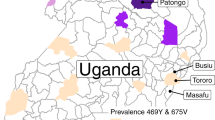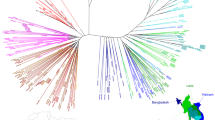Abstract
Throughout the latter half of this century, the development and spread of resistance to most front-line antimalarial compounds used in the prevention and treatment of the most severe form of human malaria has given cause for grave clinical concern. Polymorphisms in pfmdr1, the gene encoding the P-glycoprotein homologue 1 (Pgh1) protein of Plasmodium falciparum, have been linked to chloroquine resistance1; Pgh1 has also been implicated in resistance to mefloquine and halofantrine2,3,4,5. However, conclusive evidence of a direct causal association between pfmdr1 and resistance to these antimalarials has remained elusive, and a single genetic cross has suggested that Pgh1 is not involved in resistance to chloroquine and mefloquine6. Here we provide direct proof that mutations in Pgh1 can confer resistance to mefloquine, quinine and halofantrine. The same mutations influence parasite resistance towards chloroquine in a strain-specific manner and the level of sensitivity to the structurally unrelated compound, artemisinin. This has important implications for the development and efficacy of future antimalarial agents.
This is a preview of subscription content, access via your institution
Access options
Subscribe to this journal
Receive 51 print issues and online access
$199.00 per year
only $3.90 per issue
Buy this article
- Purchase on Springer Link
- Instant access to full article PDF
Prices may be subject to local taxes which are calculated during checkout



Similar content being viewed by others
References
Foote, S. J. et al. Several alleles of the multidrug-resistance gene are closely linked to chloroquine resistance in Plasmodium falciparum. Nature 345, 255–258 ( 1990).
Wilson, C. M. et al. Amplification of a gene related to mammalian mdr genes in drug-resistant Plasmodium falciparum. Science 244, 1184–1186.
Peel, S. A., Merritt, S. C., Handy, J. & Baric, R. S. Derivation of highly mefloquine-resistant lines from Plasmodium falciparum in vitro. Am. J. Trop. Med. Hyg. 48, 385–397.
Cowman, A. F., Galatis, D. & Thompson, K. J. Selection for mefloquine resistance in Plasmodium falciparum is linked to amplification of the pfmdr1 gene and cross-resistance to halofantrine and quinine. Proc. Natl Acad. Sci. USA 91, 1143–1147 (1994).
Peel, S. A., Bright, P., Yount, B., Handy, J. & Baric, R. S. A strong association between mefloquine and halofantrine resistance and amplification, overexpression, and mutation in the P-glycoprotein gene homolog (pfmdr) of Plasmodium falciparum in vitro. Am. J. Trop. Med. Hyg. 51, 648– 658 (1994).
Wellems, T. E. et al. Chloroquine resistance not linked to mdr-like genes in a Plasmodium falciparum cross. Nature 345, 253–255. (1990).
Foote, S. J., Thompson, J. K., Cowman, A. F. & Kemp, D. J. Amplification of the multidrug resistance gene in some chloroquine-resistant isolates of P. falciparum. Cell 57, 921–930 (1989).
Triglia, T., Wang, P., Sims, P. F. G., Hyde, J. E. & Cowman, A. F. Allelic exchange at the endogenous genomic locus in Plasmodium falciparum proves the role of dihydropteroate synthase in sulfadoxine-resistant malaria. EMBO J. 17, 3807–3815 (1998).
Cowman, A. F., Karcz, S., Galatis, D & Culvenor, J. G. A P-glycoprotein homologue of Plasmodium falciparum is localized on the digestive vacuole. J. Cell Biol. 113, 1033– 1042 (1991).
Desjardins, R. E., Canfield, C. J., Haynes, J. D. & Chulay, J. D. Quantitative assessment of antimalarial activity in vitro by a semiautomated microdilution technique. Antimicrob. Agents Chemother. 16, 710–718 (1979).
Doury, J. C., Ringwald, P., Guclain, J. & Le Bras, J. Susceptibility of African isolates of Plasmodium falciparum to artemisinin (qinghaosu). Trop. Med. Parasitol. 43, 197 –198 (1992).
Bray, P. G., Mungthin, M., Ridley, R. G. & Ward, S. A. Access to hematin: the basis of chloroquine resistance. Mol. Pharmacol. 54, 170–179 ( 1998).
Hawley, S. R., Bray, P. G., O'Neill, P. M., Park, B. K. & Ward, S. A. The role of drug accumulation in 4-aminoquinoline antimalarial potency. The influence of structural substitution and physiochemical properties. Biochem. Pharmacol. 52, 723–733 (1996).
Martin, S. K., Oduola, A. M. & Milhous, W. K. Reversal of cloroquine resistance in Plasmodium falciparum by verapamil. Science 235, 899–901 (1987).
Bray, P. G., Hawley, S. R., Mungthin, M. & Ward, S. A. Physiochemical properties correlated with drug resistance and the reversal of drug resistance in Plasmodium falciparum. Mol. Pharmacol. 50, 1559–1566 ( 1996).
Ward, S. A., Bray, P. G., Mungthin, M. & Hawley, S. R. Current views on the mechanisms of resistance to quinoline-containing drugs in Plasmodium falciparum. Ann. Trop. Med. Parasitol. 89, 121–124 (1995).
Bray, P. G. et al. Cellular uptake of choroquine is dependent of binding to ferriprotoporphyrin IX and is independent of NHE activity in Plasmodium falciparum. J. Cell Biol. 145, 363–376 (1999).
Su, X. -Z., Kirkman, L. A., Fujioka, H. & Wellems, T. E. Complex polymorphisms in an ∼330 kDa protein are linked to choroquine-resistant P. falciparum in Southeast Asia and Africa. Cell 91, 593–603 (1997).
Crabb, B. S., Triglia, T., Waterkeym. J. G. & Cowman, A. F. Stable transgene expression in Plasmodium falciparum. Mol. Biochem. Parasitol. 90, 131–144 ( 1997).
Wu, Y., Kirkman, L. A. & Wellems, T. E. Transformation of Plasmodium falciparum malaria parasites by homologous integration of plasmids that confer resistance to pyrimethanmine. Proc. Natl Acad. Sci. USA 93, 1130–1134 (1996).
Crabb, B. S. & Cowman, A. F. Characterization of promoters and stable transfection by homologous and nonhomologous recombination in Plasmodium falciparum. Proc. Natl Acad. Sci. USA 93, 7289–7294 (1996).
Crabb, B. S. et al. Targeted gene disruption shows that knobs enable malaria-infected red cells to cytoadhere under physiological shear stress. Cell 89, 287–296 ( 1997).
Fidock, D. A & Wellems, T. E. Transformation with human dihydrofolate reductase renders malaria parasites insensitive to WR99210 but does not affect the intrinsic activity of proguanil. Proc. Natl Acad. Sci. USA 94, 10931–10936 ( 1997).
Kirkman, L. A., Su, X. Z. & Wellems, T. E. Plasmodium falciparum: isolation of large numbers of parasite clones from infected blood samples. Exp. Parasitol. 83, 143–149 ( 1996).
Ritchie, G. Y. et al. In vitro selection of halofantrine resistance in Plasmodium falciparum is not associated with increased expression of Pgh1. Mol. Biochem. Parasitol. 83, 35– 46 (1996).
Geary, T. G., Divo, A. D., Jensen, J. B., Zangwill, M. & Ginsburg, H. Kinetic modelling of the response of Plasmodium falciparum to choloroquine and its experimental testing in vitro. Implications for mechanism of action and of resistance to the drug. Biochem. Pharmacol. 40, 685– 691 (1990).
Cremer, G., Basco, L. K., Le Bras, J. L., Camus, D. & Slomianny, C. Plasmodium falciparum: detection of P-glycoprotein in chloroquine-susceptible and chloroquine-resistant clones and isolates. Exp. Parasitol. 81, 1–8 (1995).
Acknowledgements
We thank S. Ward and P. Bray for the gift of [3H]chloroquine and for advice throughout this work, and T. Wellems and D. Fidock for providing the human dhfr gene. This work was supported by the National Health and Medical Research Council of Australia (NHMRC) and the National Institute of Health, USA. M.B.R. is supported by a NHMRC Peter Doherty Research Fellowship. We are grateful to the Blood Banks of the Red Cross of Victoria and Australian Capital Territory for generously providing serum and red cells.
Author information
Authors and Affiliations
Corresponding author
Rights and permissions
About this article
Cite this article
Reed, M., Saliba, K., Caruana, S. et al. Pgh1 modulates sensitivity and resistance to multiple antimalarials in Plasmodium falciparum. Nature 403, 906–909 (2000). https://doi.org/10.1038/35002615
Received:
Accepted:
Issue Date:
DOI: https://doi.org/10.1038/35002615
This article is cited by
-
Deaggregation of mutant Plasmodium yoelii de-ubiquitinase UBP1 alters MDR1 localization to confer multidrug resistance
Nature Communications (2024)
-
Proteome Analysis for Inflammation Related to Acute and Convalescent Infection
Inflammation (2024)
-
Population dynamics and drug resistance mutations in Plasmodium falciparum on the Bijagós Archipelago, Guinea-Bissau
Scientific Reports (2023)
-
Drug resistance of Plasmodium falciparum and Plasmodium vivax isolates in Indonesia
Malaria Journal (2022)
-
Drug resistance and population structure of Plasmodium falciparum and Plasmodium vivax in the Peruvian Amazon
Scientific Reports (2022)
Comments
By submitting a comment you agree to abide by our Terms and Community Guidelines. If you find something abusive or that does not comply with our terms or guidelines please flag it as inappropriate.



